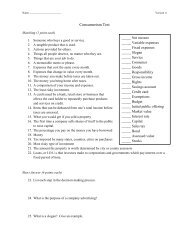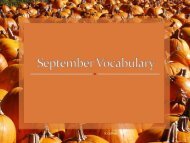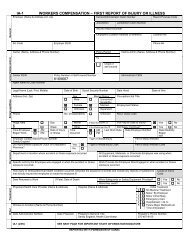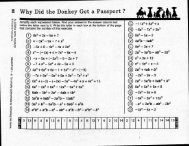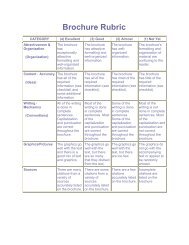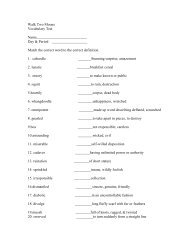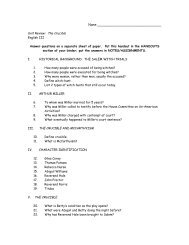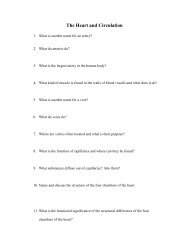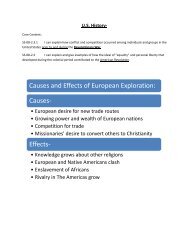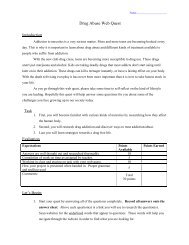7th Grade Reading
7th Grade Reading
7th Grade Reading
- No tags were found...
You also want an ePaper? Increase the reach of your titles
YUMPU automatically turns print PDFs into web optimized ePapers that Google loves.
7 th <strong>Grade</strong> <strong>Reading</strong>February 2012 J. Turner/A. MaynardWHEN ANSWERING QUESTIONS IN THIS TEST BOOKLETCORRECT MARKINCORRECT MARKSUse only soft black lead pencil (No. 2).Do NOT use ink or ball point pen.When marking your answers to multiple-choice questions, mark heavy, dark marks thatcompletely fill the circle. Mark one answer for each question.Erase completely any marks you wish to change.Make NO STRAY marks on any page of your test booklet.For the open-response questions, be sure you write your answers on the lines and spacesprovided. Answers or parts of answers written outside the boxed areas cannot be scored.1
The following is the guide that will be used to evaluate your response to the extended-responsequestion in this test.2PLEASE GO ON TO THE NEXT PAGE
<strong>Reading</strong>This test section contains total of ten multiple-choice, two short answers, and oneextended response question. Please bubble your answer for each multiple-choicequestion in the space provided on your answer sheet.Multiple ChoiceIdentify the choice that best completes the statement or answers the question.Read the short story below then answer the questions that follow.ZooEdward D. HochThe children were always good during the month of August, especially when it began to getnear the twenty-third. It was on the day that the great silver spaceship carrying Professor Hugo’sInterplanetary Zoo settled down for its annual six-hour visit to the Chicago area.Before daybreak the crowds would form, long lines of children and adults both, each oneclutching his or her dollar and waiting with wonderment to see what race of strange creatures theProfessor had brought this year.In the past they had sometimes been treated to three-legged creatures from Venus, or tall, thinmen from Mars, or even snakelike horrors from somewhere more distant. This year, as the greatround ship settles slowly to earth in the huge tri-city parking area just outside of Chicago, theywatched with awe as the sides slowly slip up to reveal the familiar barred cages. In them weresome wild breed of nightmare—small, horse-like animals that moved with quick, jerking motionsand constantly chattered around as Professor Hugo’s crew quickly collected with waiting dollars,and soon the good Professor himself made an appearance, wearing his many-colored rainbowcape and top hat. “Peoples of Earth,” he called into his microphone. The crowd’s noise died downand he continued. “People of Earth, this year you see a real treat of your single dollar—the littleknownhorse-spider people of Kaan—brought to you across a million miles of space at greatexpense. Gather around, see them, study them, listen to then, tell your friends about them. Buthurry! My ship can remain here only six hours!”And the crowds slowly filed by, at once horrified and fascinated by these strange creatures thatlooked like horses but ran up the walls of their cages like spiders. “This is certainly worth a dollar,”one man remarked, hurrying away. “I’m going home to get the wife.”All day long it went like that, until ten thousand people had filed by the barred cages set into theside of the spaceship. Then, as the six-hour limit ran out, Professor Hugo once more took themicrophone in hand. “We must go now, but we will return next year on this date. And if youenjoyed our zoo this year, telephone your friends in other cities about it. We will land in New Yorktomorrow, and next week on to London, Paris, Rome, Hong Kong, and Tokyo. Then on to otherworlds!”He waved farewell to them, and as the ship rose from the ground, the Earth peoples agreedthat this had been the very best zoo yet….Some two months and three planets later, the silver ship of Professor Hugo settled at last ontothe familiar jagged rocks of Kaan, and the odd horse-spider creatures filed quickly out of theircages. Professor Hugo was there to say a few parting words, and then they scurried away in ahundred different directions, seeking their homes among the rocks.In one house, the she-creature was happy to see the return of her mate and offspring. Shebabbled a greeting in the strange tongue and hurried to embrace them. “It was a long time youwere gone. Was it good?”And the he-creature nodded. “The little one enjoyed it especially. We visited eight worlds andsaw many things.”PLEASE GO ON TO THE NEXT PAGE 3
The little one ran up the wall of the cave. “On the place called Earth it was the best. Thecreatures there wear garments over their skins, and they walk on two legs.”“But isn’t it dangerous?” asked the she-creature.“No,” her mate answered. “There are bars to protect us from them. We remain right in theship. Next you must come with us. It is well worth the nineteen commocs it costs.”And the little one nodded. “It was the very best zoo ever…”1.Professor Hugo tells his audience in Chicago, “If you enjoyed our zoo this year, telephone yourfriends in other cities about it.” What can you infer from that remark?A. He plans to encourage interplanetary friendships.B. He is encouraging people to contact old friends.C. He wants to increase his business by word of mouth.D. He is being paid to advertise long-distance phone service.2.From the point of view of the creatures from Kaan as they are described in “Zoo,” what is strangeabout the people on Earth?A. They visit zoos and speak a strange language.B. They are horrified and fascinated by the zoo creatures.C. They walk on two legs and wear clothing.D. They use telephones and gather in large crowds.3.In “Zoo,” the he-creature remarks that the trip on the spaceship “is well worth the nineteen commocs itcosts.” Based on that statement, how would you define commocs?A. the children of the horse-spider creaturesB. the money that is used on the planet of KaanC. the caves in which the horse-spider creatures dwellD. the zoos that are constructed on the planet of Kaan4.In “Zoo,” Edward Hoch takes a look at people's views of those who are different from them. What ishis theme?A. People want to meet those who are different from them.B. Curiosity can sometimes be dangerous.C. People fear those who are different from them and so fail to see how they aresimilar.D. It is sometimes difficult for people to accept new ideas.PLEASE GO ON TO THE NEXT PAGE 4
The following editorial expresses the feelings a girl has about zoos.Zoos: Joys or Jails?Rachel F., San Diego, CAImagine your family lives in a luxurious mansion where all your needs are provided for.There are gardens and daily walks and all your favorite foods.Suddenly, you’re taken from your home and shipped to a place where people come from farand wide to ogle at you, thinking they are learning about your lifestyle. Sometimes, your captorsforce you to perform for thousands of people.Your life had changed drastically. Welcome to the zoo!Behind Bars: Behavior in CaptivityAlthough the circumstances and reasons for animals being in zoos vary, its concept hadfaults many don’t notice during their visit with the animals. Animals in many zoos are kept in areasthat are much smaller than their natural habitats. As a result, animals behave differently than theywould in their natural surroundings. Animals like big cats are accustomed to roaming territories ofup to 10 square miles.One of the best aspects of the zoo is its emphasis on education. Signs tell visitors about theanimals and their behavior in the wild, but notice how the majority say the animals were born in thezoo. Unfortunately, the adaptive behavior due to small cages gives visitors a skewed perception ofhow the animals actually behave in the wild. Although the idea of education to protect and preserveanimals is excellent, is the zoo really setting a good example of treatment or representing thenatural actions of these creatures?Survival TechniquesSome advocates say that zoos protect and serve endangered species. Despite today’sadvanced breeding techniques, animals raised in the zoo or other places of captivity are not learningthe survival techniques they would in the wild. These animals would be very vulnerable if releasedand would encounter difficulties coping. Would it not be more beneficial to raise them in theirnatural habitat?In this way scientists wouldn’t face as many risks in reintroducing captive animals raised intothe wild.Helping endangered species in the wild gives them a better chance for survival andreproduction. Scientists should only revert to the zoo if the necessary funding or habitat forbreeding is not available.Animal PerformancesAnimals are not just brought to the zoo to protect their species, but also to provideentertainment. Many animals’ lives will include performing for visitors. Four shows are performedevery day at the San Diego Zoo. The zoo should be reserved for education and protectingendangered species, not an amusement park where animals are trained to perform.Although the zoo is trying to be helpful in providing shows about animals, it is harming thoseit intends to protect. The zoo had good intentions in its educational purposes, and in breedingendangered species, but animals shouldn’t perform or be treated in a manner that could changetheir behaviors from how they act in the wild.Though zoos are meant to be a joy to viewers and teach lessons about out earth, the zoojails its inhabitants and passes on faulty knowledge. The wild animals in our world are a wonder,and they must be preserved. At the zoo they are treated with care, but they should be treated withreverence.Next time you visit a zoo, look at the enclosure of the tigers and watch the seal balance a ballon their noses, and think about what you are really learning from your day at the zoo.5PLEASE GO ON TO THE NEXT PAGE
5. What comparison does the writer make between animals’ habitats in zoos and in the wild?A. Habitats are smaller in zoosB. Habitats are bigger in zoosC. Habitats are less dangerous in zoosD. Habitats are more dangerous in zoos6. According to the writer, where do animals learn survival techniques?A. in zoosB. in the wildC. from predatorsD. from humansRead the article about polar bears and answer the questions that follow.Polar BearsEven though polar bears are extremely dangerous, they are one of the most adorable animals yousee at the Louisville Zoo. Read below to learn interesting facts and information about them.RANGE:Southern edge of the arctic pack ice, circumpolar including northernCanada, Alaska, Greenland, Norway, and Russia.HABITAT:Ice covered waters of the arctic region. Some move on land for thesummer.Average Polar Bear SizeSize Polar BearCubAdult Male PolarBearHeight 1 foot 7-9 feet 5-7 feetWeight 1 lb 900 lbs 400-500 lbsAdult Female PolarBearOrder: CarnivoraFamily: UrsidaeGenus: UrsusSpecies: maritimusLIFE EXPECTANCY:Captive: 25 - 30 yearsWild: 20 - 30 yearsREPRODUCTION:Sexually mature at 4 (female) to 8 (male) years. Mating is usually February or March here at theLouisville Zoo and can occur anytime from March to June in the wild. For several months aftermating the female feeds heavily on seals until she weighs almost 900 pounds. Delayed implantationextends the period of pregnancy to 8 months.Between October and November the pregnant female enters a maternity den hidden by snow inwhich she will give birth. The young are born from November to January. At birth each cub is blind,a foot long, and weighs about 1 pound. It has a coat of short, sparse hair. A cub of that year is calleda “coy”. The female stays in the winter den with her cubs for 2-3 months (until March or April). Shethen emerges with her cubs that now weigh about 16 pounds.PLEASE GO ON TO THE NEXT PAGE 6
7. According to the chart, how much does an adult male polar bear weigh?A. 1 lb.B. 900 lbs.C. 7-9 feetD. 400-500 feet8. According to the passage, which detail is NOT correct.A. Polar bears are carnivorous.B. Polar bears have a keen sense of smell.C. Male polar bears help raise the cubs.D. A polar bear can swim six miles per hour.9. The author’s purpose of this passage is toA. inform the readers about polar bears.B. persuade readers to save the polar bears’ environment.C. entertain readers about polar bears.D. express his/her feelings about polar bears.10. Read these sentences from the passage:Polar bears have an extremely keen sense of smell. It is said a bear can smell a strandedwhale 20 miles away.What is the denotation of keen in these sentences?A. strongB. weakC. lack ofD. coldA.8PLEASE GO ON TO THE NEXT PAGE
9PLEASE GO ON TO THE NEXT PAGE
Short Answer:11. In the short story “Zoo”, list the sequence of events for the story.12. Refer to the article “Polar Bears” to answer the following: Give two facts about Polar Bears underthe heading “BEHAVIOR”.10PLEASE GO ON TO THE NEXT PAGE
Read all parts of the question before you begin. Write your answer toextended response question in the space provided on the next page.13. Refer to all passages to answer the following:A. Compare the three passages. Cite textual evidence from each to show how they are alike anddifferent.B. If someone was writing an article on polar bears, which passage(s) would be the best to locateinformation?11



